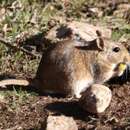en
names in breadcrumbs


Nocturnal species. Social animal and often lives in colonies in deep and complex burrows. Burrows (which are not closed) dug in clay with numerous openings, or in mounds around Nitraria retusa, Lycium and Anabasis articulata. Feeds on plants and insects especially in summer. The Breeding season of the Shaw’s jird takes place throughout of year and female gives birth to litters of around five or six naked young each year after a gestation period of 20 to 30 days. The young may live for up to five or six years.
Shaw’s jird is a large jird. Fur on the upperparts soft, dark brownish yellow and the side with clear demarcation marked by a line of yellow or orange-yellow running along the flanks and onto the outer forelegs and hind legs. Underparts white with pale yellowish area on the upper and sometimes the middle parts. Feet white. Ears prominent and pigmented with sparse hairs. Mystacial area beneath eye to base of ear slightly paler than head hairs. Conspicuous and grayish preorbital and postorbital spots. Small and whitish postauricular patch. Tail long with upper surface paler than back, and with blackish hairs while the underside of base near to a cinnamon color. Tail brush blackish, occupies about one-fourth of the tail length. Sole of the feet partly haired and unpigmented with pale claws.
Localized (Mediterranean coast).
Shaw’s jird inhabits in clay areas of Mediterranean Coastal Desert (particularly beneath Lycium or in barley fields), coastal sand dunes, sand mounds around Nitraria retusa and fig fields.
Body length: 128–160 mm. Tail length :122–155 mm. Weight: 120 gm.
Native, resident.
Shaw's jird (Meriones shawi) is a species of rodent in the family Muridae. It is found in Algeria, Egypt, Libya, Morocco, and Tunisia. Its natural habitats are arable land, pastureland, and rural gardens.
They typically live 1–2 years.[1]
Shaw's jird is able to survive long periods of dehydration in semi-desert regions where it lives, in part because of its well developed kidneys.[2] During the rainy season, Shaw's jirds breed more compared to summer when there is less rain.[3]
In the Algerian highlands, they are a main prey source for Barn owls.[4]
Shaw's jird (Meriones shawi) is a species of rodent in the family Muridae. It is found in Algeria, Egypt, Libya, Morocco, and Tunisia. Its natural habitats are arable land, pastureland, and rural gardens.
They typically live 1–2 years.
Shaw's jird is able to survive long periods of dehydration in semi-desert regions where it lives, in part because of its well developed kidneys. During the rainy season, Shaw's jirds breed more compared to summer when there is less rain.
In the Algerian highlands, they are a main prey source for Barn owls.